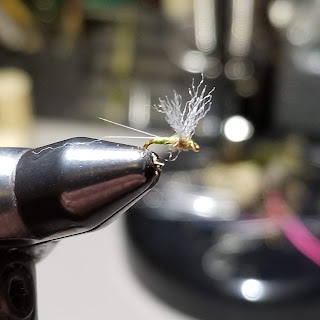The Copper Grouse
The Copper Grouse has proved itself!! In mid Winter I fished it after working a stretch unsuccessfully with another popular offering and ended up cleaning house! That happened a few more times with different flies first but the Grouse caught the most each time.
Now, I'm not a proponent of "super" flies, "guide" flies and all of that BS. PRESENTATION RULES but sometimes we will put something into a fly that makes all the difference. I guess that's what a Wooley Bugger does. Add the Partridge and Orange and the Pheasant Tail to that short effective list.
February On The EB
There is one thing we can put to rest and that is unsubstantiated feeling that our rivers are running low for this time of year. That is false. All one has to do is check out the USGS readings for our rivers and you will see that the real time flow and the median flow (average) is about the same. Also realize that these median flows average out over 70 years for most of the rivers. In short, todays flow pretty much equals the 70 year average. If we have a normal summer we will be fine.
BTW, I've been dreaming of the EB of late and of one spot where I've NEVER seen another angler except for my wife who took a monster bow one September morning from this spot. If I ever break an ankle on the EB it will be here. It has no streamside path which tells you something. NOBODY DARES TO GO THERE. It is a true rock garden with pocket water that dwarfs most other rivers and it's loaded with unmolested trout. I'll be giving some hints about this place. I'm sure my friend Gary, the Lord of the Westfield, has already figured it out.
It's been over two months since the shortest day of the year (12/21 or so). Right now the length of day is like it is in mid October. In about 2 weeks we move the clocks ahead. Time to book a trip to one of these rivers that you have always wanted to fish but....... The Millers, the Ware, The EB and the WB and the Swift await you.
Ken



















